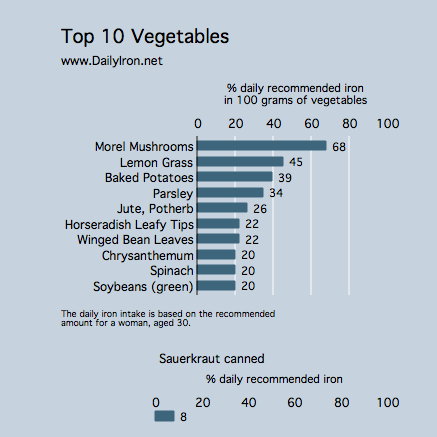Sauerkraut contains 1.4 milligrams of iron per 100 grams. Grams is a measure of weight. To put 100 grams in perspective, consider alternative measures for this food:
- 1 cup equals 142 grams.
- 1 cup equals 236 grams.
In the category of vegetables, we included whole vegetable products in the Top 10 list. We excluded dried/dehydrated products from the Top 10. You will find some dehydrated vegetables high in iron per 100 grabut they tend to be far more volume than anyone would consume. Furthermore, foods may be fortified with iron but are not included in this Top 10 list. The food tested for the particular graph below can be described more specifically as:
Sauerkraut, canned, solids and liquids
Read more about iron in vegetables or visit our iron-rich foods list.

Vegetables in general are not an exceptional source of iron. Those vegetables that do have a lot of iron also tend to be high in iron inhibitors, making it difficult to take in a considerable amount of iron from the vegetable itself.
Yet, even a vegetable with minimal iron can play an important role in iron metabolism. Vegetables are often high in vitamin C, which will help you metabolize the iron in vegetarian food items; sauerkraut is a medium source of vitamin C.
As an example, you may wish to combine peppers and tomatoes with a whole grain main dish or with beans to improve your metabolism of the iron in your meal as a whole. A raw pineapple salad with your dinner would also improve your iron absorption because of the fruit’s content of vitamin C. A glass of fruit juice is also an effective strategy.